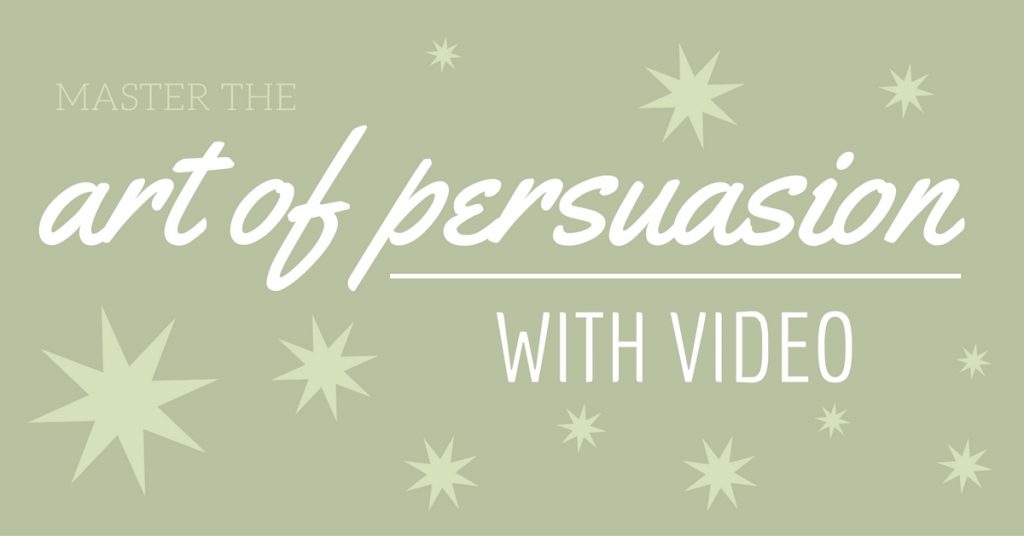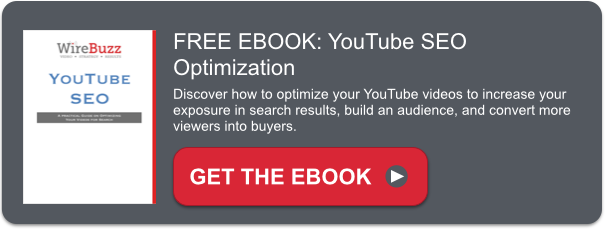Why Video Is The Most Persuasive Form of Content
by MARCUS KRIEG, on Dec 15, 2014 10:01:00 PM

It’s frustrating, isn’t it?
You’ve done your market research.
You’ve created a product that solves a unique problem in that market.
You’ve even found efficient ways to put that product in front of your ideal prospects.
But for some reason, you’re struggling to get the sale.
Sound familiar? If so, your landing pages may have a persuasion problem.
Emotion and Attention: The Two Most Important Elements of Persuasion
Before people can even consider buying your product, you need to hold their attention, which is no small feat.
In fact, humans have an average attention span of only 8 seconds, one second less than a goldfish!
It’s nearly impossible to persuade people to buy your product within such a short timeframe; just ask a billboard designer.
So for that reason, advertisers and copywriters have historically emphasized strategies that increase attention spans, including devices like:
- Storytelling
- Writing great headlines
- Making outlandish promises
- Etc.
But attention is only half the battle. You also need to facilitate an emotional connection with your audience.
Oftentimes that involves identifying your ideal prospect’s biggest problems and explaining how your product helps solve them.
The challenge from there is maintaining your prospect’s attention long enough to offer your solution.
Before explaining how to improve attention spans, let’s examine why it’s so difficult to maintain in the first place.
The Attention Problem
Each time you finish a sentence, you have to make a decision as to whether or not you’ll read the next.
Work is friction. In marketing, friction is the devil; and it doesn’t take much for your prospect to hit the back button.
Remember the last time you stopped reading a sales page part-way through? Why did you stop reading?
Was it too slow-to-the-point? Confusing? Or maybe it didn’t seem relevant to you?
Most of the time, you’re probably right. It wasn’t relevant.
But often enough, you stopped reading before getting to the “good stuff,” the part that answers your question or helps you solve a problem you’ve been facing. You missed it!
And so have many of your prospects.
Pro Tip: Not sure when your prospects are leaving? Consider using scroll reach heat maps for your website to see how far down the page your average visitor scrolls. When it comes to heat mapping software, ClickTale is the market leader.
But for most small to medium-sized businesses, CrazyEgg works great at a fraction of the cost.
If you're a WordPress user, you can also get reasonable insights from SumoMe’s Heat Map plugin, which is free.
Long story short, copywriting is a tough gig.
Fortunately, there’s a solution that helps you attract and maintain attention, while strengthening your prospect’s emotional connection with your product.
The solution is video.
How Video Solves the Attention Problem
One of the biggest advantages to including video on your sales page is that it provides information passively.
According to Forbes research, 59% of senior executives would rather watch a video than read text.
But aside from the obvious fact that people would rather avoid reading, a work-like activity, this passive learning provides a significant advantage when it comes to retaining your prospect’s attention.
In the case of reading, each completed sentence requires an active decision to read the next.
But with video, the opposite is true. When someone starts watching your video, they begin passively absorbing your message. They actually have to go out of their way to stop watching it by clicking pause or hitting the back button. Huge, right?
Don’t take my word for it, though: MarketingSherpa found that videos double the amount of time visitors spend on your web page. Put simply, videos double your prospect’s attention span.
Why Video Is More Persuasive Than Other Content Types
While video is effective at maintaining the attention of your viewers, its biggest advantage lies in its ability to transfer information more quickly and with higher emotional appeal.
Before digging into the psychology of persuasion, consider the three following stats:
- 90% of the information that is transmitted to the brain is visual
- Video information is processed by the brain 60,000x faster than text
- Website visitors are 85% more likely to buy after watching a product video
Powerful stuff.
So we know from the data that video is more persuasive than written copy, but why?
Well, without getting too deep into human psychology, let’s take a moment to examine how the brain works and the ways in which video affects decision-making.
If you want to skip the nerdy-science-stuff, jump ahead to the section on “Visual Processing vs. Conscious Processing.”
How People Make Decisions -- The 3 Sections of the Brain
For our purposes, we’ll be looking at three distinct “sections” of the human brain. [Note: This is a gross simplification.]
The first section is common to most vertebrates and is popularly known as the “lizard brain.”
This portion is the most powerful, as it’s responsible for answering the three essential questions of life:
- Can I eat it? [Sustenance instincts]
- Can it kill me? [Fear and fight or flight instincts]
- Can I have sex with it? [Reproductive instincts]
Because these are the three core necessities for the survival of a species, they supercede all other sections of the brain. They are “hard-wired” in.
It’s why food commercials make you salivate, even when you’re not hungry. Or why “sex sells,” even when you’re in a relationship. In terms of danger, our pesky fight or flight instinct disrupts our lives on a daily basis, from road rage in the morning to the anxiety we feel before getting on stage.
These triggers cause us to have immediate, physiological reactions that are outside our conscious control.
The second section of the brain, or “mammal brain,” is exclusive to mammals. This middle section is responsible for emotional processing (amongst other things, like memory creation), which like the lizard brain, also happens on an unconscious, near-instantaneous basis.
You’ve probably heard that people make decisions based on emotion, and only later post-rationalize their decisions with logic. That conclusion is actually supported by the research. The mammal brain allows us to make decisions by evaluating the relative emotional “costs” and “benefits” of a decision.
This section of the brain is fascinating, because while it operates subconsciously, it can be influenced by the third section of our brain, which is called the cerebral cortex.
The cerebral cortex, unlike the other two brain structures, operates on a conscious level. This region is responsible for creativity, logic, and language. Ultimately, it’s the extra development of this region that separates humans from other mammals.
Visual Processing vs. Conscious Processing
When you read text, for example, your must interpret letters into words, words into sentences, and sentences into ideas. This all happens in the conscious language center of the brain (cerebral cortex). Those ideas are then assigned positive or negative emotional weights by your mammal brain.
Only then can you make decisions.
That’s actually an extremely slow process compared to what our brains are capable of.
Unlike textual information, which must first be filtered through the cerebral cortex, visual information is immediately interpreted by our mammal brains. Instant emotion.
That’s why visual information is processed 60,000x faster than text, why a picture is worth a thousand words, and why people tend to be visual learners.
On this basis alone, it’s clear that your brand should be making extensive use of visual media on your sales pages.
You should use photos, graphics and videos to help tell your product’s story. By doing so, you’ll take advantage of seemingly-instant processing power compared to asking people to “work” for information.
But if photos and other imagery can help transfer information and emotion instantly, why use video?
Video Transfers More Information Than Images Can Capture
When it comes to persuasion, one of video’s biggest advantages is the ability to transfer visual and auditory information at the same time, which research has shown to increase information retention.
A few of the advantages of video compared to other visual media include the ability to transfer information (or emotion) through:
- Tone of voice
- Body language
- Facial expressions
- Music
- Stories
- Etc.
Basically, video allows you to use both auditory and visual cues to tell a more compelling story. And if your video is designed strategically, these elements will work synergistically to create an emotional state that encourages buying behavior.
Sounds logical enough, but what does the research have to say?
Well, Allan Paivio of the University of Western Ontario performed research on this topic. He had three groups of test subjects. Each group was assigned something either to read, listen to, or watch.
72 hours later, he tested their information recall and found that people remembered about 10% of what they read, 20% of what they heard, and an astounding 68% of what they watched on video.
His conclusions line up with what psychologists would expect based on how the brain processes different types of information.
Coupled with the endless supply of conversion case studies that confirm video’s persuasive advantage on websites, it’s safe to say that video is the most persuasive media type available.
Additional Case Studies:
Case Study 1: SixPackAbsExercises.com
Case Study 2: BrookdaleLiving.com
Case Study 3: CrazyEgg.com
Test It For Yourself
Now that you understand how video can increase sales from your website and email campaigns, consider creating a video and testing it yourself.
Simply record your web page’s conversion rate today.
If you’re not sure how, it’s quite easy. Just divide the total number of sales from your landing page by the total number of visitors to that page. Make sure that you go back far enough to get a good sample size of over 1000 visitors. For most businesses, looking at one month’s data should be sufficient for this purpose.
Typically, you’ll see a number between 1-8% (in case you’re curious, the internet average is around 2%).
Next, you want to create a compelling video that tells your product’s story. Once you’ve added it to your web page, run the numbers again after 30 days (or whichever timeframe you used for the first data set).
Most businesses see at least a 30% increase in revenue, but some have seen improvements well over 100%.
Have you run any conversion rate tests with video on your sales pages? If so, tell us about your conversion rate increase in the comments below!

